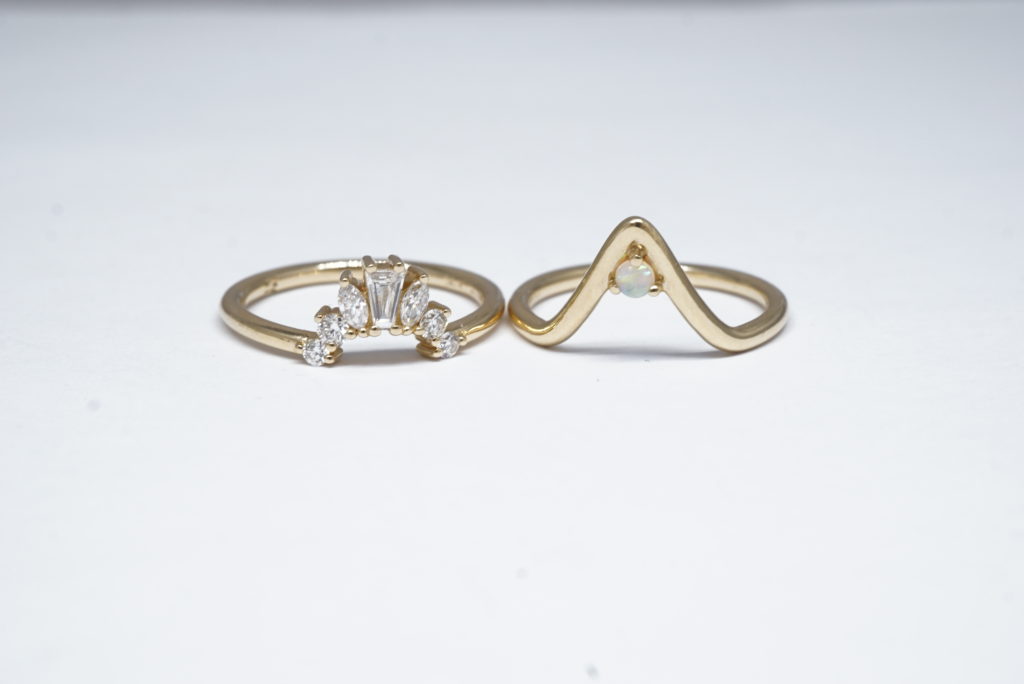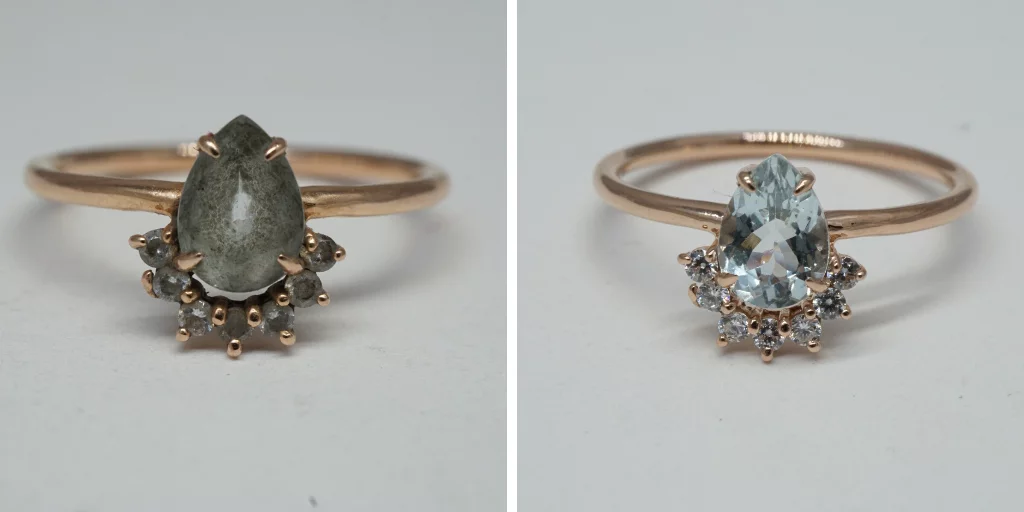12 Jewelry Terms that Every Jewelry Lover Should Know
Written by Anna Currell
February 16, 2023

If you love jewelry, you probably have some go-to styles. You also might know that jewelry comes in a variety of shapes and types and often has a lot of technical elements. Having a better understanding of the jewelry industry lexicon can help you shop for new jewelry, get beloved pieces repaired, and even enjoy and care for your jewelry properly. Here are 12 jewelry terms that will deepen your jewelry knowledge:
Appraisal
A jeweler or gemologist can perform an appraisal, which will determine specific details about the quality, craftsmanship, materials, and values of a piece of jewelry based on standard criteria. A professional appraisal should result in an official document outlining all of the piece’s characteristics and stating its overall value. It’s important to hang onto this document in case you ever choose to sell or get your jewelry insured.

Example Jewelry Appraisal
Clasp
A clasp is the small metal piece that connects the two ends of a chain together, allowing you to put on and take off necklaces and bracelets for example. Some clasps are small and difficult to use, like lobster clasps, but there are other options that are more accessible; permanent jewelry eliminates the need for clasps altogether, and some clasps get creative with helpful tools like magnets that require less dexterity.
Diamond Quality
The quality of a diamond is determined by four factors: carat, clarity, color, and cut. Here’s what those measures represent:
- Carat: A carat is the measurement of a diamond’s size and weight. One carat unit is about 200 milligrams, and jewelers get very precise about carat measurements. Usually, the bigger the carat, the more expensive the stone and the better quality the diamond.
- Clarity: Clarity is the measurement of the flaws present in a diamond. A high clarity diamond means that there are no imperfections, which are often referred to as “blemishes” or “inclusions.” Fewer flaws means a better quality diamond.
- Color: A diamond’s color can range from dark yellow or brown to completely clear. The more transparent the diamond, the higher its quality. The scale used to determine the color of a diamond is lettered; a colorless diamond is rated a letter D or F, and letters from G-Z represent increasingly tinted stones.
- Cut: The cut of a diamond is the way in which the diamond is shaped. Diamonds form into rough shapes as they grow, and jewelers cut them in specific ways to turn them into the wearable stones we know and love. The way a diamond is cut can affect its quality; certain angles allow the light to pass through a diamond better, making a shinier, sparklier piece of jewelry.

A chart detailing the clarity and color grading system
Earring Back
An earring back is the part of an earring that holds it in place. There are all types of shapes and styles an earring back can take, including:
- Leverback: A leverback earring is made with a hinge that clicks together through the ear piercing. This is a secure type of earring back, but it can be trickier to clasp together than some other options because the two pieces have to be latched together just so.
- Omega: These earrings typically have a wire that goes through the ear piercing, with a small, hinged piece (shaped like the Greek letter omega) that snaps over the wire to hold the earring securely in place.
- Stick post: A stick post is a straight metal stick that you can insert directly into your ear piercing. It slides into a separate backing piece, often a butterfly backing, to secure the earring to your ear from behind.
- Screw back: A screw back is similar in shape to a stick post earring, but the back is carved like a screw. The separate backing will screw onto the post to keep the earring even more secure.
- Wire: A wire earring back is shaped like a shepherd’s hook and doesn’t necessarily need another piece to secure it to your ear. It will glide through the earlobe and curve downward, sometimes accompanied by a rubber stopper to keep it in place.
Electroplating
Electroplating is a process that coats a piece of jewelry in a layer of metal like gold or rhodium. If you have any metal-plated jewelry, this is probably how it was made: a base metal is covered with a layer of either gold, silver, rhodium, or another precious metal. The electroplating process involves dipping a piece of jewelry into a vat of liquid and metal ions, and the jeweler will use electricity to fuse the metal onto the piece. If you want to improve the luster (or shine) of a piece of jewelry and add another layer of protection from everyday wear and scratches, electroplating is a great option.
Enamel
Enamel is the result of fusing a fine colored compound, like powdered glass, to a metal surface. This creates a bright effect and can add bold and interesting features to your jewelry. If you enjoy a bit of color, like you might find on a Hidalgo ring, you can consider getting enamel detailing on a piece of metal jewelry.
Jump Ring
A jump ring is a small metal loop that connects different parts of jewelry, like chains and clasps, dangling earrings and their backings, or pendants hanging from chains. If a jump ring comes apart, it’s normally a very easy fix that won’t even require soldering. A jeweler will typically pinch the two ends of the metal loop together with pliers to reshape the connection point.
Karat
A karat (not to be confused with a carat) is the measurement of how much gold is in a metal. It’s often indicated with the letter K; 24K signifies 100% gold. Anything less than 100% pure metal is considered an alloy, which is a blend of different metals. Keep this in mind when you’re shopping for jewelry; a higher karat count is usually more expensive, but also much more valuable and durable.
Ring Shank
A ring shank is the part of a ring that encircles the finger; it’s sometimes referred to as the ring band. It’s typically made of metal, although some ring shanks are made of other materials like acrylic, for example. You’re most likely to hear this term when you’re assessing your ring size, because the circumference or diameter of the shank is the part of the ring that’s measured to calculate the final size.
Soldering
Soldering (with a silent “L”, pronounced saw-der-ing) is the process of fusing two metals together. Jewelers use soldering irons to repair and create chains, rings, and earring backs. If your necklace chain breaks, if your ring is the wrong size, or if your earring backing ever breaks off, a jeweler will use a soldering iron to fix your piece by fusing the metal back together.
Setting
A setting is the part of any jewelry that attaches the gemstone to the piece. Ring settings come in all sorts of styles, like:
- Bezel: A bezel setting holds a gemstone in place using a secure metal lining surrounding the perimeter of the stone.
- Channel: A channel setting sets a row of gems into the band of the ring between two metal walls that create, you guessed it, a channel where the gems can sit securely.
- Pavé: A pave setting includes many tiny gemstones that are set closely together, normally around the band of the ring. This effect makes the entire ring sparkle.
- Prong: Prongs are metal tabs that reach up over the top of a gemstone to hold it firmly in place. There are many different prong types that all create different visual effects.
Tarnish
Tarnish is the result of a metal undergoing a chemical reaction; it can develop when residue builds up on a piece of metal jewelry or when the jewelry is exposed to water. Discoloration and dulling can both be signs of tarnishing. To prevent tarnish, avoid getting your metal jewelry wet and be sure to wipe it down with a soft cloth at the end of each wear to clean off any lotions, perfumes, or bacteria.
With these new jewelry terms in your back pocket, you can shop for jewelry you love, take care of the jewelry you already own, and build a beautiful, long-lasting collection that can grow with you over time. If your jewelry needs an appraisal, a soldering service, or just a good cleaning up, send it in to our expert team at Quick Jewelry Repairs. We’ll be happy to help!


